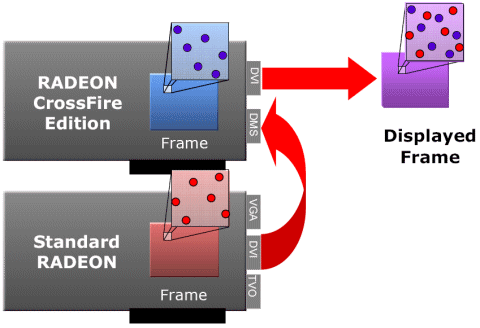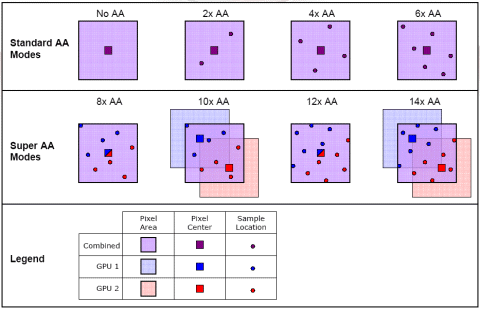Super AA Mode
There are many situations where current high end graphics boards are already limited by other parts of the system - when the frame rates exceed refresh rate of the display, on older titles that are very CPU limited or on LCD displays where you can't go above a certain resolution. To help address such cases where a game will not see the benefit for a second board ATI are providing another mode, which is again a direct descendant of the processing that is useful in high end workstations: Super AA.
ATI's FSAA can operate up to 6x Multi-Sample FSAA for a single board with their current DirectX9 graphics processor, but they use a sparse sampling mechanism that has a sub pixel accuracy to a 12x12 grid - in other words, for every pixel they could support up to 144 different sample points. 144 Multi-Sample FSAA is not feasible on a single board due to the inevitable low performance and because the ROP's (render output units) can only handle a certain number of samples in the cache and compression schemes;and in the case of the R300 and R420 series this goes up to 6 samples. However, ATI can leverage this sparse sampled, programmable FSAA mechanism into CrossFire to offer FSAA modes above those supported by a single board.

Super AA Process
With Super AA mode each of the two boards will be rendering the entire frame, effectively they will be duplicating the workload, however one board will render with one FSAA sample pattern whilst the other board will render with an alternate sample pattern. Each board will then resolve the FSAA samples down to the display resolution and both images will be send to the compositing device on the master card two blend each of the pixels from the two images together, which gives a resultant colour value from the two boards that equates to the same value as though they were calculated on a single board at the higher level of FSAA.

Super AA Process*
* Note: the may not be representative of the final sample patterns, we will look at this when we have access to the hardware.The standard advantage of Multi-Sampling is that not all data needs to be rendered multiple times in order to anti-alias the screen - other than the cost for the extra samples in the ROP's and the bandwidth required to support them, the only extra costs are at triangle edges where multiple colour values need to be calculated. In the case of SuperAA that advantage is lost a little as there is implicitly some level of inherent Super-Sampling occurring as, although each of the boards are performing Multi-Sampling up to either 4x or 6x FSAA, they are both calculating the same pixels. To this end ATI are not just offering straight Multi-Sampling modes (which correspond to 8x and 12x FSAA) but also some mixed modes that have each of the boards render the pixel centers off axis from one another, giving the increased FSAA effect of mixed 2x Super-Sampling, each with 4x or 6x Multi-Sampling, which will assist in reducing texture aliasing a little. Unfortunately, ATI have chosen to call these mixed modes 10x and 14x FSAA, which isn't really the case as they are really still have 8x or 12x sampling positions, but with two pixel centers as opposed to one - evidently this decision was taken to make the user selection a little more easy on the driver control panel; rather than having a flag to to enable different sub-pixel centers that would only work on two modes, the 10x and 14x descriptions will just fit in along a single slider.
Logically 8x and 12x modes (just straight Multi-Sampling) operating on two well matched boards could perform similarly to 4x and 6x respectively on a single board with like performance, assuming the application isn't limited by the host interface, however we have discovered that in this mode only, for some reason, the transfer of the frame from slave to master occurs over the PCI Express bus which is likely to reduce performance a little. The modes with two pixel centers should also have a very slight increased texture overhead as the texture LOD should be increased slightly to compensate for the increased samples being blended together. As each board is rendering the same image, which is then down-sampled to the display resolution prior to blending the two images together, there shouldn't be any buffer overlay issues that have previously occurred with Super-Sampling.
When CrossFire boards are coupled together and FSAA is selected up to the level that a single board can natively handle then either SuperTiling, Scissor or AFR modes will be used with each board rending that level of AA; when rendering a greater level of FSAA than a single board can handle (8x-"14x") then the Super AA rendering methodology is utilised.
